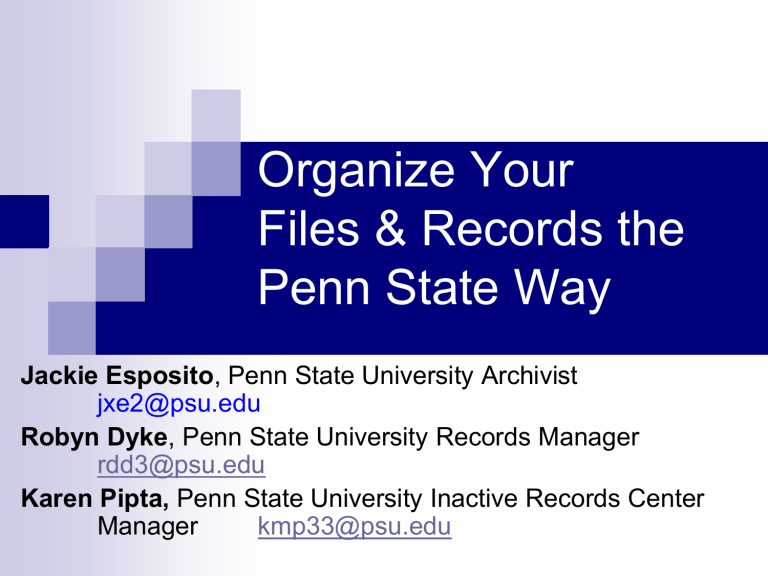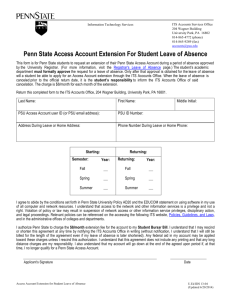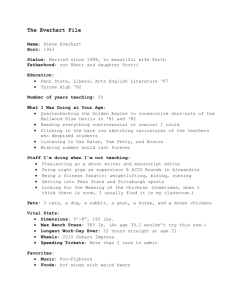Organize Your Files & Records the Penn State Way

Organize Your
Files & Records the
Penn State Way
Jackie Esposito , Penn State University Archivist jxe2@psu.edu
Robyn Dyke , Penn State University Records Manager rdd3@psu.edu
Karen Pipta, Penn State University Inactive Records Center
Manager kmp33@psu.edu
THE RECORDS MANAGEMENT
PROGRAM ENCOMPASSES:
Compliance with Federal Laws and Regulations Relative to Records
Management
Policies, Procedures and Retention and Disposition Schedules
Vital Records Management
Electronic Records Management
Files Management System Design and Development
Procedures for Sending Records to the University Archives and/or
Inactive Records Center
FERPA – Family Educational Rights and Privacy Act
(Buckley Amendment), signed into law August 21, 1974; effective November 19, 1974
Protects the privacy of student education records .
The Act affords parents the right to access and seek to amend their children’s educational records up to the age of 18. When a student turns 18, or enters a postsecondary institution (at any age), the rights transfer from the parents to the student.
FERPA allows the student to have some control over the disclosure of personally identifiable information from the educational record.
POLICY AD11 – UNIVERSITY POLICY ON
CONFIDENTIALITY OF STUDENT RECORDS o o o o o
How Penn State complies with FERPA.
Protects students privacy in telling “us” how to handle student records.
Transcript is the official student record.
The Department of Education monitors FERPA – said that you can get rid of everything else when they graduate. [Five years after they left the University.]
*November 4, 2009 - Minor changes made in these sections: Student Record Policy , Student Educational
Records , Definition of Student , Public Information Regarding Students , and University Officers Responsible for
Student Records . Significant additions made to Disclosure of Information to Third Parties and Disclosure Under
Emergency Conditions sections. Addition of a new section entitled Disclosures Concerning Sex Offenders .
Privacy Act of 1974 effective September 27, 1975
Omnibus code of fair information practices.
Regulates the collection, maintenance, use and dissemination of personally identifiable information .
The purpose of the Privacy Act is to restrict disclosure of information about individuals with the rights of the individuals to be protected against unwarranted invasions of their privacy.
Health Insurance Portability and
Accountability Act (HIPAA) Privacy Rule effective August 21, 1996; revised August 14, 2002
Established a set of national standards for the protection of certain health information .
The Privacy Rule addresses the use and disclosure of individuals’ health information as well as standards for individuals’ privacy rights to understand and control how their health information is used.
Federal Rules on E-Discovery
Passed December 2006
Requires procedures for and access to electronic business records in their original format within 30 days of receipt of subpoena
This may require confiscation of individual records or entire systems depending on the scope of the subpoena.
Paperwork Reduction Act effective September 30, 1995 (revised from 1977)
Minimizes the paperwork burden for individuals, offices, businesses, contractors, governments, and other persons.
Ensures the greatest possible benefit from and maximize the utility of information created, collected, maintained, used, shared and disseminated.
Coordinate, integrate and make uniform policies and practices as a means to improve productivity, efficiency, and effectiveness of information collected. Provide for the dissemination of information on a timely basis, on equitable terms and in a manner that promotes the utility of the information.
LIFE CYCLE OF RECORDS
Historical Records Act effective June 19, 1934
Any record created more than 20 years ago may have historical or evidentiary value and should be reviewed by the Archives for possible long-term retention.
Vanashing – in the next half- Century
Snail mail – Revenue will dry up for the U.S. Postal Service as we continue to trend toward Electronic Correspondence.
Home phones – People will drop their land-line plans and opt for cellonly. Eventually we will be talking on mini-computers the size of cellphones.
Physical Media – Goodbye CDs, DVDs, Blu-Rays, thumb drives, video game discs – and their players. Electronic entertainment will be bought and played directly from internet.
Desktops – Employees will all have laptops, saving to a “cloud” – virtual server for data storage accessed through the Internet. Soon, all of the computing power we need will fit onto our phones.
Analog clocks – Our cellphones, synched perfecting to satellites, never forget to spring forward.
Cursive – Hawaii, Indiana, Illinois and Ohio have officially dropped handwriting as an educational requirement.
PENN STATE UNIVERSITY
ARCHIVES
What are Historical and Archival Records
We create records to remember and to communicate information. Usually the information we record gradually becomes less important to save. Thus, most records can and should be discarded within a few years of their creation.
However there is a small percentage of any person’s or institution’s records whose information continues to be useful to society long into the future. Such records may be letters, reports, or other types of written documents, or they may be audiotapes, videotapes, maps/blueprints, photographs, computer data, or any of a myriad of formats.
These records are referred to as historical and archival .
The determination that a record has historical or archival value rests not on the form of the record, but rather on the fact that it contains information of enduring administrative, legal, fiscal, or cultural value to the creating institutions or to researchers. The benefits these records provide to us depend on our ability to retain them in useable condition.
ITEMS THAT ARE COLLECTED
BY THE UNIVERSITY ARCHIVES:
Correspondence (In organizations, particularly of officers)
Charter, ByLaws, or Constitution
Legal Documents
Minutes of Meetings
Reports of Committees and Records of their activities
Annual Reports
Position Papers
One copy of every Publication
Testimony before Legislative or Investigative Bodies
Membership Records
Photographs, Scrapbooks, Albums
Articles about Person/Organization
Writings
Addresses, Speeches, and Talks
Diaries and Journals
Moving Image and Sound (Films, Videotapes, Audiotapes, CDs, DVDs)
Reminiscences or Interview Transcripts and Tapes
Funded Research Proposals and Project Documentation
POLICY AD35 – UNIVERSITY ARCHIVES
AND RECORDS MANAGEMENT o
In existence since May 1991 o Mandatory compliance effective as of October 30, 2007 o
Liability policy to protect the University.
o
AD35 provides rules for the capture, use, storage, and disposition of all University records and to assure effective access to those records which are designated as archival.
o
This policy is applicable to all areas of the University. o
*Certain areas may have individual guidelines which supplement, but do NOT supplant this policy.
Records Liaisons
Under revisions to AD35, approved as of October 30,
2007, every unit of the University MUST appoint a records liaison to work directly with Records Management staff to ensure compliance with AD35.
Who is your Records Liaison? Master list maintained by
Robyn Dyke.
Records Management
Guidelines
“Is this a record?” Questions to ask:
1.
2.
3.
Does this document help me perform my job?
Is this the original, non-note, non-draft copy of the document?
Am I the creator and/or the designated records holder?
If the answer to all three is YES : Record!
(Needs to be scheduled)
If the answer to any of these is NO : Non-Record!
(Can be discarded at your convenience)
Retention, Disposition and Destruction Schedule -
Definition
GURU Administrative Schedules 18 & 21 represent
PSU’s General and Financial Retention schedules
Schedules provide guidance to ALL university offices for the LEGAL period of time to retain, dispose of, and destroy University records. Schedules represent LEGAL minimums.
Records Series
TYPES OF DOCUMENTS
Class Lists
Staff Review and Development
Evaluations
Admission Applications (Images)
Commencement Programs
RETENTION PERIOD
3 years
3 years after superseded
7 years
5 years; Permanently Maintained in
Archives
Commencement Programs
News Releases
Budget Reports
Credit Card Receipts
Operating Fund Reconciliation
Wage payroll time slips or time clock cards
5 years; Permanently Maintained in
Archives
3 years; Transfer to Archives
Current fiscal year plus one year
7 years
Current fiscal year plus two years
Current fiscal year
1.
2.
3.
4.
5.
6.
7.
8.
9.
10.
Top 10 Reasons to not get
Organized!
Hunting for important documents adds excitement to a boring schedule.
Stacking papers on your desk protects it from ultraviolet radiation.
Being as confused as everyone else helps you fit in.
Moving piles of paper keeps you in shape.
If you understood what you were doing, you would be terrified.
Confusion brings out the best in you.
Organization kills creativity.
Shuffling papers prevents dust from piling up.
Your coworkers will never find what they’re seeking.
Clutter magnifies your importance.
Records Management is:
o Preserving yesterday, Managing today,
Preparing for tomorrow.
o o
Ensuring access to essential information.
Just saying “No!” to chaos.
o Knowing what to throw away.
o Increasing efficiency, reducing costs.
o The only profession that knows in advance what it is going to forget.
Born Digital –
Definition & Consequences of
BORN DIGITAL – Any records created and maintained electronically including email, webpages, datasets, newsletters, correspondence, etc.
CONSEQUENCES – If a record created electronically is identified as a University record, it MAY be subject to retention, disposition, and destruction electronically.
UNIVERSITY GUIDELINES ON
RETENTION OF E-MAIL
If an e-mail message is a University record (as defined in AD-35) it is subject to the same retention period as the paper equivalent.
E-mail messages which require long-term retention should be either retained electronically on retrievable media or printed, including all header and transmission information, and filed with their electronic or paper equivalents by the sender/recipient .
Liability for email can become involved when such documents
(paper or electronic) are not available to be provided during some segments of litigation. Be aware that your decision to retain or destroy an e-mail message may become an issue in a court situation.
Email Etiquette
1.
2.
3.
4.
5.
6.
7.
8.
Be informal, not sloppy – use standard writing protocols
Keep messages brief and to the point
Use blind (bcc) and courtesy copy (cc) appropriately
Remember email isn’t private
Be sparing with group emails
Use the subject field to indicate content and purpose – this practice will help sort and apply retention periods
Use a signature that includes contact information
Summarize long discussions
EMAIL – Steps YOU Can Take to Better
Management your Inbox
1.
2.
3.
4.
5.
6.
Close your Email Client – Keeping your email client open all day, leaves you vulnerable to distraction every time a message arrives.
Set Specific Times to Check your Email – By setting specific times and adhering to them, you will greatly reduce the distraction of email.
Reduce Attachment Spam – Only send attachments to those who need it. Alternatively use a link instead of an attachment.
Touch Each Message Only Once – File it, respond to it, take action related to it, defer it, delete it, etc.
Don’t use email as a filing cabinet – Email systems are “designated to send, route, receive, and store messages for short periods – they are not designed to be the final repository for information.”
Use the Right Tool for the Job – Wikis are better tools for collaboration. Blogs (and Twitter) are better ways to stay informed.
Check the clutter at the door.
RECORDS MANAGEMENT TIPS
Use Colors – Color-Code File categories for easier identification and classification. Use “primary colors”.
Be Retention Conscious – File your records according to their retention period. All records that can be disposed in 2 years should be filed together NOT with records that have a longer retention.
Label Folders with Disposal Date: When records are filed, they should be maintained with the disposal date and action clearly identified.
Create a File Structure – Decide on a specific system for your files
(alpha, subject, numeric, functional, etc.), codify it, and post it for all staff members to utilize when filing.
Keep No Secrets – Label all incoming correspondence with its file category for the first time you see it. Like multiple-choice quizzes, your first choice is usually the correct one.
Remember the 20-Year Rule – Any record created more than 20 years ago MUST be transferred to the University Archives to review.
INACTIVE RECORDS CENTER
Karen Pipta, Manager, kmp33 (814 865-3276)
On June 1, 2008 IRC became part of the Records Management Program.
This service has a fee since the records are not archival (permanent)
Offers storage and retrieval services for inactive records that need to be maintained for longer than three years but do not have permanent retention value (not archival).
All records are stored in a security-controlled environment.
Offices can access these records during regular business hours, or records can be delivered as needed.
Offers – records shredding including the Blue Bag Program.
Blue Bag – Confidential Records Shredding
Services
ONLY refers to confidential paper records . Includes records with personally identifiable information such as Social Security numbers or Penn
State Identification numbers, Budget and Fund numbers, or information related to a specific person who maintains an expectation of privacy.
Do NOT have to have paper clips removed.
Manila folders are accepted within Blue Bags IF confidential information is written on the folder itself. Pendaflexs are NOT accepted.
Do not over fill your Blue Bags.
Blue Bags MUST be maintained in a safe and secure storage location while awaiting pickup.
BLUE BAG FAQS
WHO can participate: Departments who actively participate in the University’s Recycling
Program.
WHAT is the process: Department contacts Al Matyasovsky ( aem3@psu.edu
) 863-4719 to arrange drop off and pick up of Blue Bags. Bags will be picked up, on average, once every two weeks (1 & 3 or 2 & 4 Thursdays) or upon demand if volume warrants. Empty bags are dropped off when ¾ full bags are picked up. All bags are delivered to the
University’s Inactive Records Storage Center where they are shredded and added to the
University’s mixed office paper recycling program.
WHERE are Blue Bags Located: Awaiting pick up bags are to be kept in a safe and secure storage location.
WHEN can Blue Bags be picked up: Bags will be picked up, on average, once every two weeks (1 & 3 or 2 & 4 Thursdays) or upon demand if volume warrants.
WHY : To provide safe and secure confidential records destruction throughout the
University.
Planning for Tomorrow
Be Aware of User Patterns
ALWAYS refer to Retention Schedules
Set Aside Time Weekly to Organize Files
Use and Share your Established Structure
File and Index for Maximum Access
And, ALWAYS Remember, You are YOUR OWN Best
Customer!!
– Penn State
University Records Management
Information
Category: Common Interest Activities
Description:This group discusses current
University policies, practices and procedures related directly to Records
Management issues.
Privacy Type: Closed : Limited public content. Members can see all content.
Organize Your Files &
Records the Penn
State Way
Jackie Esposito , Penn State University Archivist jxe2@psu.edu
Robyn Dyke , Penn State University Records Manager rdd3@psu.edu
Karen Pipta, Penn State University Inactive Records Center
Manager kmp33@psu.edu





